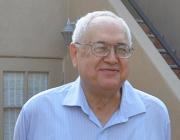Date Published:
SEP 27Abstract:
Three approaches are combined to study the electronic states' dynamics in the photodissociation of F-2 and OF in solid argon. These include (a) semiclassical surface-hopping simulations of the nonadiabatic processes involved. These simulations are carried out for the F-2 molecule in a slab of 255 argon atoms with periodic boundary conditions at the ends. The full manifold of 36 electronic states relevant to the process is included. (b) The second approach involves quantum mechanical reduced-dimensionality models for the initial processes induced by a pump laser pulse, which involve wavepacket propagation for the preoriented OF in the frozen argon lattice and incorporate the important electronic states. The focus is on the study of quantum coherence effects. (c) The final approach is femtosecond laser pump-probe experiments for OF in Ar. The combined results for the different systems shed light on general properties of the nonadiabatic processes involved, including the singlet to triplet and intertriplet transition dynamics. The main findings are (1) that the system remains in the initially excited-state only for a very brief, subpicosecond, time period. Thereafter, most of the population is transferred by nonadiabatic transitions to other states, with different time constants depending on the systems. (2) Another finding is that the dynamics is selective with regard to the electronic quantum numbers, including the A and Q quantum numbers, and the spin of the states. (3) The semiclassical simulations show that prior to the first ``collision'' of the photodissociated F atom with an Ar atom, the argon atoms can be held frozen, without affecting the process. This justifies the rigid-lattice reduced-dimensionality quantum model for a brief initial time interval. (4) Finally, degeneracies between triplets and singlets are fairly localized, but intertriplet degeneracies and near degeneracies can span an extensive range. The importance of quantum effects in photochemistry of matrix-isolated molecules is discussed in light of the results.
